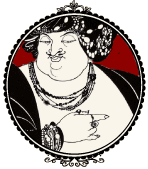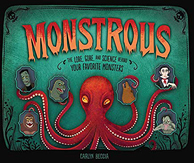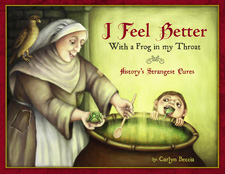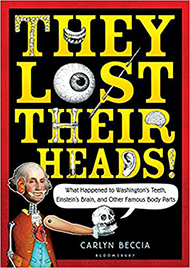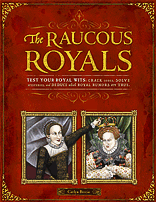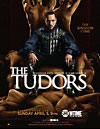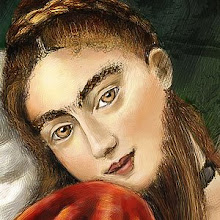
In Episode seven, Henry has fallen in love. Unfortunately, the object of his affection is a small miniature portrait and not the real woman it portrays. The miniature (shown here) is truly beautiful and can be seen in the Victoria and Albert Museum. Aside from her stunning portrait, most reports of Anne’s beauty were favorable too. The English ambassador, Christopher Mont reported that, ‘She excelleth the Duchess [of Milian], as the golden sun excelleth the silvern moon.’ (The Tudors uses this quote). This comment would be kind of like trying to fix a guy up on a blind date and saying, “She looks like Julia Roberts….except hotter". As discussed in
last episode, The Duchess of Milan was truly the Julia Roberts of her day. We can imagine how high the bar was set.
Meanwhile, things are getting messy in England. The Spanish and French ambassadors have been recalled—a clear sign that war is about to be declared on England. Cromwell suggests a Cleves marriage to protect England from Franco-Imperial forces and Henry agrees. Henry has now become desperate for the support of the Schmalkaldic League. Just trying saying Schmalkaldic three times and you will understand why he was so desperate.
Later, Chapuys appears in a meeting with Henry and tells him that it was just rumors that he had been recalled and that he never left. This is not exactly true. Chapuys was recalled but not for an extended period.
Meanwhile The Duke of Suffolk and Edward Seymour are up to no good. They decide to patch up their quarrels and unite in the common goal of bringing down Cromwell. In reality, the Duke of Norfolk and Stephen Gardiner were the main faction moving against Cromwell . More on that later…
When Mary hears about the Cleves marriage, she has a hissy fit and has a few choice words for what she thinks of a Lutheran queen. As discussed in last week’s post, Anne was a Catholic. But most importantly, Mary never wished Anne to the “bottom of the sea.”But this is sort of a real line from history. Anne Boleyn had supposedly wished Catherine of Aragon and all her Spanish cohorts to the bottom of the sea. Good line. Wrong person.
The Tudors shows Brandon meeting Anne in Calais, but in reality it was Lord Lisle who had been instructed to greet her. What is true is the foreboding weather we see in the background because Anne’s departure from Calais was delayed due to strong winds. The person in charge of entertaining Anne was Admiral Fitzwilliam. (The Tudors shows the hunky Brandon as Anne’s chief entertainer…and who really can complain about another scene with Brandon?) The card game that Brandon (Fitzwilliam) and Anne play was called ‘cent’ and by Fitzwilliam’s report, Anne was a quick learner.
Anne and her party then set sail for the Downs where they were met by Brandon and his wife, but the weather was still so bad that it caused further delays. Henry became so impatient to meet his beloved that he decided he must go to her instead and “nourish love.” (a real quote) The scene that unfolds simply doesn’t do the true meeting justice. In the Tudors, Henry rushes to Rochester with a gift of sables. As soon as he lays eyes on Anne, he is repulsed and leaves without giving her his gift of sables. Boo hoo.
 Why bull-baiting makes a terrible first date
Why bull-baiting makes a terrible first dateIn reality, Shakespeare could not have written a better tragic comedy for Anne and Henry’s first meeting. Anthony Browne, A gentlemen of the King’s chamber who was very close to the king, left us a
first hand account of their botched first meeting. Here is what really happened:

New Year’s day was almost over and Anne was watching the bull-baiting out the window of her chamber. In 16th century England, bull-baiting and bear-baiting were as patriotic as making fun of the
queen’s hats is today. Anne didn’t get out much in Cleves so we can imagine that she must have been feeling a mixture of awe and….my these English are a much of hooligans! In walks Henry. But he isn’t dressed as Henry with his usually 80’s style puffy sleeves and ridiculously tight hose. He is dressed in a bear suit.
No, I jest. He wasn’t dressed as a bear because that would have been actually funny. But he was disguised as a regular old fat courtier. If you and I were there, we might immediately have said,…Look! There is big fat Henry and not been fooled one bit. But Anne had never seen the 6.2 king and wasn’t expecting any pranks. To Henry, these were not pranks, but part of the ritual of courtly love. Henry, like others of his day, believed that your true love would always see through any disguise. Unfortunately, Anne had not been schooled in the art of English flirting and she was too engrossed in the bull-baiting to notice her true love. Henry then left the room and reentered dress like a king. Anne suddenly realized she had just dissed the king of England….not a good start to marital bliss.
Henry then returns to court and mutters his infamous quote, “I like her not!” (In the Tudors, he says it three times…that might be overkill) Henry screams, “She looks like a horse…a Flanders Mare!” As discussed in an
earlier posting, Henry never said this infamous line.
A bunch of finger pointing on whom exaggerated Anne’s appearance then follows. The scene does provide some comic relief when Hutton makes the anachronistic comment, “I told you that I was no good with women.” Although this comment made me giggle like Kathryn Howard on a swing, Wotton did say in one of his reports, ‘I knowledge myself of judgement herein very ignorant. ‘ Sorry Cromwell. He warned you.
Heads are going to fly! Henry warns, “I am not well- handled.”( a real quote) . He then tells Cromwell that he has been backed into a corner and, 'if it were not that she had come so far into my realm, and the great fear of making a ruffle in the world and of driving her brother into the arms of the Emperor and the French King, I would not now marry her.' Politics had locked Henry into an unwanted marriage, but political alliances could change quickly…as we shall see later.
We must remember that many of those surrounding Henry might have been shocked by his reaction. By all accounts, Anne was very pretty. She came with the backing of the Schmalkaldic League and an impressive royal lineage. She was intelligent and could read and write in German. (It is doubtful Jane could read and write). She was rumored to be virtuous which was VERY important to Henry as we will see later with Miss Giggles. And although she could not dance, sing, flirt or play any instruments, she was a whiz with a needle and thread. But alas, Henry didn’t need a wife to make shirts.
Henry then sent his council scrambling to find a legal loophole out of the wedding. He says, 'Is there no remedy, but that I needs must put my neck into the yoke?' (The Tudor uses this quote.) Cromwell certainly better find a remedy or he is going to find his neck yoked with the edge of a blunt axe.
Henry goes through with the wedding, but he looks like he about to have 10 teeth pulled instead of wedding a beautiful girl. In reality, Henry appeared perfectly content in public.
When is a pear not just a pear?
Meanwhile, Cromwell catches a young boy of his court trying to steal a pear as he is praying in his chambers. The boy is shocked to see Cromwell not praying in church. Cromwell then gives him the “god is everywhere” lecture and tells the boy that he does not need to go to church to talk to god. This is what I was taught in Catholic school, but it was heresy then. In the 16th century, the church had a monopoly on god. If you wanted to pray, you had to come to church. If you wanted forgiveness, then you had to pay for an indulgence. If you wanted to get married, then you had to go to the church. We tend to take our freedom of choice for granted, but it was something 16th century people had to fight for. (and that’s all the lecturing I will do on religion…promise)
Also of note is the significance of the pear in this scene. I can’t take credit for this one because I am simply not this observant, but a reader on the Tudor discussion board pointed out that a pear in Christianity symbolized Christ’s love for mankind. (In the above painting of the Madonna and Child she offers up a pear. ) Some might argue that a pear is just a pear, but I think the writers’ choice was not arbitrary.
On Henry and Anne’s wedding night, they are up
really late but unfortunately…they were not doing newlywed things. They were playing cards. In their bed, Henry is so repulsed that he appears to have some amusing performance problems. Many historians have proposed that Henry may have been impotent by this point so this scene is not pure Hollywood.
The next day, Cromwell asks Henry what he thinks of Anne and Henry replies, 'Surely, my lord, I liked her before not well, but now I like her much worse! '(The Tudors uses this quote) Henry even suspects Anne’s virginity. His evidence was the, 'looseness of her breasts and other tokens'—a sure sign by 16th century standards that the filly had been broken in. Henry then claimed that he could not be, ‘stirred to that act’ and left her as good a maid as he found her. Henry later confides to Doctor Butts that he can not perform with the queen because he finds her body so “disorderly”. He places the blame squarely on Anne because he has had several wet dreams . (yes, he really said this). Poor Anne. Did I mention she was handy with a needle?
Cromwell then meets with Anne and tells her to do everything she can to please the king. We have no record of such a conversation taking place, but it is interesting to get a dramatic portrayal of what Anne might have thought. In the Tudors, she tells Cromwell that Henry is no prize with his stinkin leg wound.
The Tudors ends with a scene between Lady Bryan and Anne where Lady Bryan is forced to give her “the birds and the bees” conversation. Anne tells her that the king kisses her goodnight and asks her…isn’t that enough? If we look back at what the real Henry looked like, one would say….sheesh that IS enough. This scene did happen, but the conversation took place with Lady Rochford and not Lady Bryan. The episode ends with Anne asking the question on everyone’s mind, “If I cannot please the king, will he kill me?
Stay tuned to for the final episode of Historical vs. Hollywood to find out…


